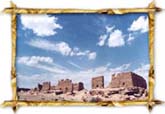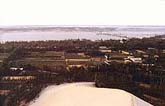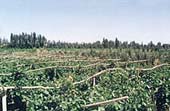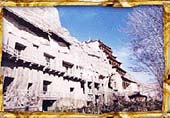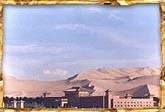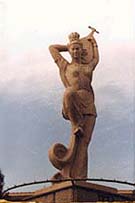History Dunhuang
Dunhuang has a long history. As early as the New Stone Age there had been buman beings living on this land. Dunhuang County, which was built in the 6th year of Yuanding of Wu Enterer (111 BC), Han Dynasty, owns a history of over 2,000 years. At the beginning of Western Han, the Huns occupied this area. After his succeeding to the throne, Emperor Wu sent Zhang Qian, |
|
a senior official, as an envoy to the Western Regions for the first time in the 3rd year (138BC) of his reign. Then, in the spring of 121 BC, he sent troops led by Biaoji General Huo Qubing to recapture Dunhuang and set up the Yang Pass and the Yumen Pass. In the 2nd year of Yuanding (115BC), Han Dynasty, Zhang Qian visited the Western Regions as an envoy for the second time and opened up the Silk Road. So Dunhuang enter its thriving stage for the first time and developed stop by step into the northwestern military and political center, Besides, it was also an important place for trade and culture, becoming a large metropolis, which connected the people of Han Nationalities with the tribes in the Western China. From Western Han to Western Liang, Dunhuang suffered from chaos caused by wars, and rose and fell for over 400 years.
In 366 AD, Monk Yue Seng opened up the Mogao Grottoes for the first time. And in Northern Wei, they had become very prosperous, then China was unified in Sui Dynasty and as a result the Silk Road was ensured unblocked and the Buddhism in Dunhuang entered a period of great prosperity. A lot of caves, murals and sculptures which were made in Tang Dynasty had reached to a very high artistic level. In the 19 th year of Zhenguan (645 AD), after getting Buddhist scriptures from the Western Regions, Monk Xuan Zang got back to Chang'an via Dunhuang. Dunhuang was occupied by Tubo Dynasty in 781 AD. In 851 AD, Zhang Yi, arich person in Shazhou, convened a lot of people of Han, Hui and Longqiang Nationalities to revolt and then recaptured this land. But in 1036 AD, Li Yuanhao, the leader of Dangxiang Nationality captured Dunhuang. And in the same year, the world-famous "Dunhuang Surviving Works" were sealed up for safekeeping in Mogao Grottoes. In 1036 AD, Dunhuang became a part of Western Xia. And in 1227 AD, the Western Xia was conquered by Mongolian troops. From then on, Dunhuang was under control of them. In Yuan Dynasty, the culture in Dunhuang became unprecedentedly prosperous and the business transaction between this land and Western Regions became more and more frequent.
In 1403 AD, the leader of Dunhuang came over and pledged allegiance to Ming Dynasty. And in 1524 AD, it became a part of Tulufan Kingdom. In the 54th year of Kangxi, Qing Dynasty, the royal troops recaptured Dunhuang. And in the first year of his reign, Emperor YongZheng set up Shazhou Section in Dunhuang and promoted it to Shazhou Guard two years later. He also sent a lot of troops and forced people to go there to plough and sow seeds. Besides, he ordered to divert the water of Danghe River to Dunhuang and divide it into 10 ditches to irrigate the farmlands. As a result, Dunhuang became an oasis in the desert. In 1760 AD, the authorities of Qing Dynasty promoted Shazhou to Dunhuang County. On Sept 28th 1949, it was liberated in peace and on Oct. 7th, the People's Government of Dunhuang County was established. On Sept. 28th, 1987, it was changed from a county to a city and was designated by the State Council as one of the first cities open to foreigners. In 1986, it was named the Famous City of China for History and Culture. In 1992, the government of Gansu Province approved it to be Dunhuang Tourist and Economic Development Region.
Geography Dunhuang
|
Dunhuang is situated in the very western end of Hexi Passage in Gansu Province, located in the juncture of 3 provinces, namely Gansu Province, Qinghai Province and Xinjiang Uygur Autonomous Region, and under control of Jiuquan Region. It is a small basin with a very particular geographical environment, which links the qilian Mountains from the south, |
the large desert from the west, the Hexi Passage from the east. Deserts, gobi, oasis, mountains and lakes are all shown in this area, and they enhance beauty of each other with fertile farmlands and abundant natural resources. The average height above the sea level in Dunhuang is 1,138 meters. It covers altogether 312,000 square kilometers. The Danghe River, which is originated from the glacier in Qilian Mountains, runs through the whole oasis with endless stream. It is 390 kilometers in length with a runoff of 0.328 billion cubic meters per year. So it can irrigate 300,000mu fertile farmlands.
Climate Dunhuang
Dunhuang is located in the inner land and separated by high mountains far from the humid maritime climate. So it is under control of the dry continental climate. The first characteristic of its climate is the amplitude of sunshine. The average sunshine hours per year can reach to 3,200 hours. It has 150 frost-free days every year, and the average temperature of the year is 9.3 degrees centigrade with 24.7 degrees centigrade in July and 9.3 degrees centigrade below zero in January. |
|
The second feature is the aridity and the lack of rainfall. A north-inclined sinking air current constantly surrounds the Dunhuang region. Therefore, this region has always been dry and lack of rainfall with clear days all through the year. The rainfall of each year is only 39.9 millimeters while the evaporation can reach 2,400 millimeters. The third feature is the distinction of four seasons with long winter and short summer as well as the great difference in temperature between day and night. It is just as the saying goes: "to wear a fur-lined jacket in the morning, a yarn-made clothes at noon; to eat the water melon near a stove".
Natural Ecological Environment Dunhuang
Dunhuang is called the Desert Oasis. People can get bumper harvest of wheat, cotton, maize, fruits and vegetables every year. The great differences in temperature between day and night plus the dryness and hotness make the fruits high qualified with copious saccharine, delicious taste and a unique characteristic. Among them, the Liguang apricot, Dangshan pear, Ziyang peach, Mingshan date and Huanghe sweet melon are all the excellent fruit products. During the spring period. Dunhuang is very charming with all kinds of flowers. The fragrance can be smelled a lot of miles away, gladdening the heart and refreshing the mink. In the summer season, the paths on the whole oasis crisscross in the fields are with billowing wheat waves, green shades and countless fruits. In the autumn, the farmlands are filled with the scent of the fruits and the cotton fields look promising.
The grape glitters under the shelves. On the grasslands, the flocks of sheep look like the drifting white clouds. The nature has drawn a beautiful picture of bumper harvest. In the winter, all kinds of vegetables are planted in the greenhouses.
Therefore, there have always been the supplies of fresh vegetables on the market during the whole year.
Economy Dunhuang
Dunhuang owns its unique land, sunshine, water conservancy, agricultural by-products, mineral products and tourist resources. Among them, the tourism, agriculture, industry and trade are the four important pillars of Dunhuang. Since the Third Session of the Eleventh Central Committee of the Communist Party of China (CPC), the municipal Party Committee and the government of Dunhuang have formulated the economic development strategy of being thriving with tourism, stable with agriculture, competent with industry and vigorous with trade. According to the thought of setting the industry as the most important one in order to bring along the other three to get advanced, they speed up the construction of tourist reception facilities and city auxiliary facilities and develop tourist products. They consoled ate the foundation of agriculture, adjust the industrial structure, develop the varieties of the fruits and vegetables, build greenhouses and attach great importance to the highly efficient agricultural industry of three-dimensional planting.
Besides, they also develop the tourist products with unique characteristics of Dunhuang, such as the handicraft carpet, phosphorescent jade made cup, colorful sculpture, statue of Buddha, crystal glasses, crafted camel, calligraphy and painting, stone statue, woodcut and industrial art ceramics. So, the economy of Dunhuang has been developed quickly and exceedingly through establishing markets and accelerating the circulation. In 1996, Dunhuang took the lead in becoming a comfortably off city. The per capita income of peasants reached to 3,027 yuan. The income of its tourism made up 22.4 per cent of the gross national product. Nowadays, Dunhuang is striving towards being an international tourist place and a more comfortably off city.
Culture Dunhuang
|
Culture is the most important traits of Dunhuang and is world-famous for its extensive knowledge and profound scholarship. In 1879, Loc chi Kasnishi, President of Hungarian Geology Society and the first foreign scholar to visit China, exclaimed with admiration after he appreciated the Mogao Grottoes arts. In 1902, at the International Oriental Study meeting held in Hamburg, Germany, |
he told the scholars from Britain, Germany, France and Russia how magnificent and exquisite the Dunhuang arts were. It drew their great attention and interests. In 1900, the discovery of Buddhist scriptures cave in Mogao Grottoes surprised the academia of China and foreign countries even more. Over 50,000 pieces of scriptures written in ancient letters, volumes of Buddhist scriptures, many kinds of silk, pictures, linen paintings, printing products of carving plates, gold-bronze and woodcut statues of Buddha were found in the cave. The so-called scholars of many countries spitted three-feet-long drool with envy for this.
Therefore, in the following 10 years, these so-called scholars and explorers from Britain, Germany, France and Russia plundered a large amount of Dunhuang relics. Since the culture of Buddhist scripture caves was known by the world, the scholars from a lot of countries have made step-by-step research of Dunhuang culture in the fields of plastic arts, murals and architecture by using different methods from all aspects of theoretical courses. So, a special subject which is called the Study of Dunhuang has been formed in the international scientific research.
A Survey of Tourist Industry Dunhuang
Since adopting the policy of reform and opening up to the outside world, the Communist Party of China and authorities have attached great importance to the research of Dunhuang culture and arts, and to the construction of Dunhuang tourist city. In 1986, Wan Li, the Chairman of the National People's Congress, inspected this place and pointed out that Dunhuang should become an international tourist city with its own unique characteristics. |
|
In 1992, Jiang Zemin, the general secretary of the Central Committee of the CPC, also inspected this city and pointed out that the Long-term foresight is needed, and the large airport and hotels should be built in order to make Dunhuang an international tourist city. In the April of the same year, the government of Gansu Province granted to set up the Dunhuang tourist and economic development area.
In recent years, all previous municipal Party Committee and municipalities insisted on developing the economy, taking advantage of its unique tourist resources, combining the tourism with the development, giving prominence to the key points, laying solid foundations and improving its investment environment constantly. Besides, the tourist reception facilities are now beginning to take shape. The construction of the city and the auxiliary facilities have been improved increasingly in order to develop the tourist industry. Especially in recent 5 years, 148 construction projects have been finished and a total amount of 470 million yuan has been absorbed as investment.
Among them, the foreign capital reached to 190 million yuan. Therefore, a group of well-equipped high-grade restaurants and hotels have been newly built up, such as Dunhuang VIP Buikling, Dunhuang Villa, International Hotel, Sun Hotel, Shazhou Hotel and Dunhuang Hotel.
After the construction of many years, its comprehensive reception capability has made great progress. The large-scaled and well-equipped infrastructure can provide all kinds of good services, including transportation, meals, hotels, traveling service, shopping place and entertainment. The total of all kinds of hotels, restaurants has reached 105. they have nearly 8,000 beds to accommodate people with lodging. Among them, nearly 5,000 are standard beds. Nowadays, Dunhuang owns 16 hotels which are high graded or foreign related, 12 domestic tourism-nominated restaurants, 14 travel agencies and branches which run businesses for international and domestic tourism, 2000 professional people who are taking part in tourist services, 108 license-holding guides who can speak 6 different languages, over 900 travel automobiles that can provide 9000 seats and among which 700 are cabs that can provide 6000 seats. All the persons that take part in tourist services should be trained and examined. And only after getting the qualified licenses could they start their job. As a result, the standardization in tourist services has been enhanced and the procedure level raised continuously. In recent years, Dunhuang has received many VIPs of China and foreign countries, including Deng Xiaoping, Jiang Zemin, Li Peng, Qiao Shi, Li Ruihuan, Zhu Rongji, Zou Jiahua, Wu Bangguo, Tian Jiyun, Wan Li, Li Tieying; Noboru Takeshita, Japanese Prime Minister; Li Guangyao, the former Singapore Premier; Nala, the Indian President; and Sirindhorn, the Thai Princess.
Since China opened up to foreign countries in 1979, the number of domestic visitors to Dunhuang has increased at an average rate of 14 per cent and foreign visitors 25 percent. By the end of 1998, the number of domestic and international visitors to this place has added up to 5,35 million. Among them, the foreign visitors 0.45 million and only in 1998, the number reached 0.52 million. The total income of the tourist industry has made up 22.4 per cent of the GNP of this city. And the tourism has become an irreplaceable pillar industry in the economic development of Dunhuang.
The Tourism Symbol of the City Dunhuang
|
Dunhuang is the hometown of flying Apsaras. So the tourist symbol of this city is two lithe and graceful flying Apsarases inlaid in double rings with the words of Dunhuang Tourism both in Chinese and in Dnglish. These words in the double rings symbolize that the international and domestic tourist businesses for Dunhuang help each other forward and develop together in order to make this city world-famous. Flying Apsaras is the Xiangying God in Buddhism and takes charge of welcoming and seeing off the visitors. It symbolizes the profound cultural connotation. The Dunhuang tourism is a high level one in conjunction with culture. The ardent and honest local people of this place will welcome all visitors of China and foreign countries. The slowly up-going flying Apsarases symbolize that the Dunhuang tourism will become more and more prosperous and thriving. |
City Symbol Dunhuang
The city symbol of Dunhuang is a white marble-made Buddha statue with an up-side-down pipe, a plucked string instrument with a fretted fingerboard. It was taken from the Cave 172 of the Dunhuang Mogao Grottoes. A beautiful, gentle and affectionate Buddha with an upside down pipe symbolizes that Dunhuang is the Holy Land of culture and arts, and its arts have reached the peak of perfection.
|
